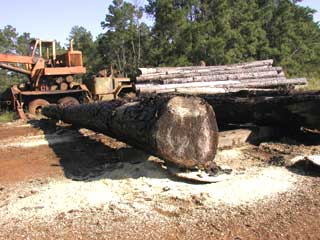The Southern Yellow Pine logs were secured from a tract of land near Groveton Texas.
The logs produced from the tract are exceptional and will produce quality timbers
for the frame. Below are some pictures of the logs and the initial milling process.
|
When the logs were delivered to us the moisture content of the log is still "forest
green". We keep the logs wet to inhibit the germination of molds and fungi
until they are sawn. One of the most common molds is called "blue stain"
for the bluish pigment the mold produces. A pile of logs, as seen here, is called
a log set. You can just see the sprinkler jet behind the log loader in the picture.
Logs are delivered to us in 33 foot lengths and each log truck will hold about 32
tons of logs.
|

|

|
Before a log is moved to the saw mill it is "bucked" (cut) to length and
the end pieces are removed. You can see an end piece just to the right of the log
and of course the saw dust from the chain saw. This log has yet to be bucked.
Log diameters average 12" to 14" and some even larger depending on the
frame requirements. We provide John Box, our sawyer, with a complete list of all
timbers needed for a frame so he knows exactly what to produce.
|
Here the logs have been moved to the saw mill and are ready for the initial cuts.
The mill we use is a band saw mill rather than a circular or sash mill. Band mills
produce very accurate cuts and slight "kerf". Kerf is the amount of wood
that the saw blade removes as it works through the wood. Reducing kerf reduces waste
and produces a cleaner cut.
John will inspect each log to determine the best way to mill it to fit a specific
size and length on the saw list, then position the log on the mill to make the first
cuts.
|

|

|
Here, John is making shallow passes with the saw blade to remove the outside bark.
A timber is produced by removing shallow sections of wood at a time; reading, turning
the log and making a new cut until a four sided timber is revealed.
|
Only two sides of this log have been cut but it will soon become a square timber
as the two remaining sides are sawn. A four sided square timber is called a "cant"
but it is not yet to cut to size.
One inch thick boards will be cut from each face of the cant until the final sawn
size is achieved. You should notice that the center, or heart, of the tree becomes
the center, or heart, of the timber. This "boxed heart" cut equalized
the forces exerted by the individual wood fibers thus greatly reducing bowing, twisting
and warping of the final timber.
The next step for this sawn timber will be the dry kiln.
|

|

|
This is an interior view of the dry kiln where you can see some of your timbers
stacked on the left. The drying process takes 28 days to fully dry the timbers to
a moisture content of about 16% to 18%. Drying the timber greatly reduces its tendency
to shrink which reduces checking (cracks along the face of the timber) and helps
ensure tight joints in the finished frame.
|
|
These timbers have been kiln dried. The boxed hearts are plainly visible. You should
also notice the DVS stamp on the timber ends. DVS is the customer reference tag.
That's how we keep all the timbers separate from other projects. We cut only what
we need for the frame and a few extra timbers just in case. Each timber is meant
to fit a specific location in the frame. The next step for these timbers is our
timber sizer. The timber sizer dimensions and squares the sawn timbers.
|

|